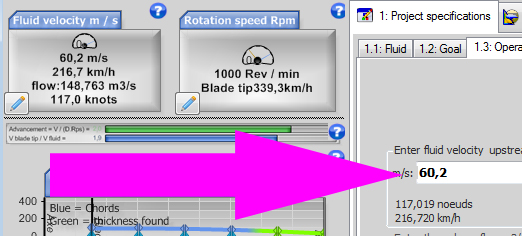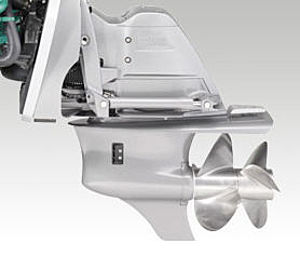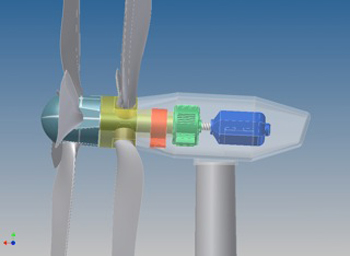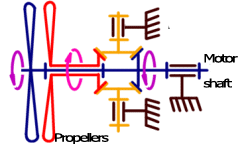Design: propeller, turbine, screw, aerial, marine, turbine, tidal, wind, kaplan, foil, wings, 3D. Discover heliciel software:
Understand and master the counter rotating propellers :
This article provides an example design of a pair of contra-rotating propellers with software HELICIEL
- The contra rotating propeller has several advantages:
- removal torque reversal and gyroscopic torque, resulting in increased maneuverability.(for air crafts)
- wake straightened, the energy lost in the rotation flow rate of the fluid is recovered by the second propeller
- smaller diameters
- and some disadvantages:
- greater complexity
- for marine propellers:
- Air craft propulsion propellers:
- Some wind turbines also start to use the gain provided by the recovery of the rotation of the fluid by the first propeller:
- Hydraulic turbines, equipped with stator (guide vanes) may be considered as contrarotating turbine whose first propeller is fixed ..
.
For completeness, the Heliciel software must enable the design of contra-rotating propellers, incorporating a parameter tangential flow upstream.
A multirotor interface (added since version 11.0.0) now allows you to directly model a pair of contra-rotating propellers, or drone multirotors and VTOL "Vertical Take-Off and Landing" ,and test the performance of the system in Heliciel. See the “Contra-rotating propellers” video tutorial:
...explanation:
The counterrotating propeller consists of two counter-rotating propellers:The first propeller is optimized as a normal propeller.We therefore use héliciel to calculate and create a normal propeller.
For example we will use (let's open a model of air proppeller and set parameters):
- a three-bladed propeller, (tab3: optimize)
- tip radius 900 mm and root 17%,(tab 2.1 blade dimensions)
- chord root=197 mm and tip chord=82mm
- Chords equation parameters: -0,0002894943 *r² + 0,1508884*r + 180,6908
- rotating at 1000 revolutions / minute,(tab 1.3operating point)
- moving to 201 km / h (56 m / sec):(tab 1.3operating point)
The second propeller, which is located downstream, will receive a diverted fluid stream (tangential component) and accelerated (axial component) by the upstream propeller. The second propeller must therefore be twisted, and pitch optimized with fluid parameters speed, different from the first. It will of course also have a reverse rotation. To create our downstream propeller, we will use the results of our upstream propeller to determine the fluid velocity at the inlet and the tangential component parametrer:In the results area, from our upstream propeller, at the element at around 0.75 times the radius of the blade (element 4) (most effective area of the propeller), we note the downstream axial velocity: 60.2 m/sec (this will be the fluid velocity of our second propeller) and the tangential speed downstream: 7.7rad / sec (this will be the value of the tangential flow introduction of our second propeller)

After you have saved our upstream propeller, we transform it, to downstream propeller by changing the fluid velocity from 56 m/sec to 60.2 m/sec, because it is this axial speed that receive our downstream propeller.

The propeller also diverted upstream flow, in rotation,we will use the parameters menu / introduce tangential flow, to enter our value of 7.7 rad / sec previously noted. Note that the value of the tangential flow introduced must be negative, in our case, because it is contrary to the direction of rotation:

We have to rebuild with this new data, to calculate the twist and the performance of our downstream propeller:

We reverse the direction of rotation in the 3D tab to rebuild an inverted geometry before export to a cad to igs formatsthe thrust forces, of the upstream and downstream propeller, will be cumulative, as well as their torque to the shaft and power, if you want to know the power, torque and total thrust from our counterrotating propeller. The efficiency can sometimes exceed 1 at the downstream propeller, because it is calculated without taking into account the contribution of the tangential flow of energy that is brought, and thus gives a surplus of abnormal power. But the average efficiencies of the two propellers will give us an overall efficiency therefore more realistic and less than 1.
The design function of contra-rotating propellers has been made even easier with the multirotor interface integrated into the Heliciel software since version 11.0.0:






 Global site map
Global site map Mecaflux
Mecaflux Tutorials Mecaflux Pro3D
Tutorials Mecaflux Pro3D Tutorials Heliciel
Tutorials Heliciel Mecaflux Store
Mecaflux Store Compare software functions
Compare software functions Quotes, Orders, Payment Methods
Quotes, Orders, Payment Methods project technical studies
project technical studies